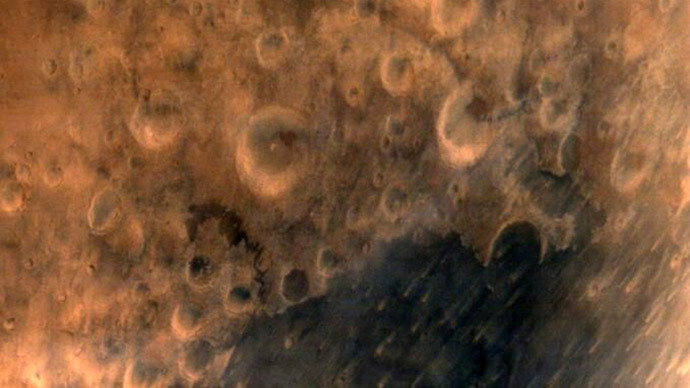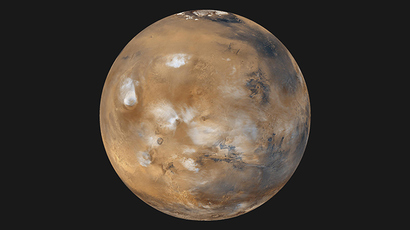#SpaceBuddies: India’s chatty Mars orbiter spurs flurry of Red Planet tweets

India’s Mars Orbiter entered the planet’s orbit exactly a week ago, joining the Mars Curiosity Rover and others in their studies of the red planet. It has since been honing its photography skills and making friends with the other Mars spacecraft.
“The view is nice up here,” The Mars Orbiter Mission
(MOM) reported upon arrival, extending the hand of friendship to
its grounded counterpart.
MOM was launched by the Indian Space Research Organisation (ISRO)
on November 5, 2013. It has since making a mass of friends on
social media, and seems as eager to compensate for its isolation
with excessive chattiness.
Something's brewing here! pic.twitter.com/ecX1t6onXp
— ISRO's Mars Orbiter (@MarsOrbiter) September 29, 2014
The NASA Curiosity Rover, renowned for its lighthearted tweets,
welcomed it joyfully. “Namaste, @MarsOrbiter! Congratulations
to @ISRO and India's first interplanetary mission upon achieving
Mars orbit,” it tweeted Wednesday.
ISRO also reached out to the European space agency and the NASA
Voyager which it said had ventured out the farthest.
“I'm alone, but not lonely. I talk to the Deep Space Network
& carry a Golden Record of greetings from Earth,” NASA’s
Voyager recently reassured its followers.
I'm alone, but not lonely. I talk to the Deep Space Network & carry a Golden Record of greetings from Earth http://t.co/Mott7GcAk6
— NASA Voyager (@NASAVoyager) September 26, 2014
The ESA welcomed the craft with open arms: “It can get lonely in deep space, good to have friends! #SpaceBuddies @MarsOrbiter” it tweeted.
Hey @MarsOrbiter@MAVEN2Mars, hope you’re settling in well at #Mars, I was there in ’07! http://t.co/02mUBNXH0ipic.twitter.com/RAFZYbToLf
— ESA Rosetta Mission (@ESA_Rosetta) September 29, 2014
With practice, ISRO has also reported progressive improvements
with its photography skills – despite bemoaning the fact that it
cannot take selfies.
It uploaded a photograph of the Limb of Mars taken with the Mars
Color Camera from an altitude of 8,449 kilometers. “I'm
getting better at it. No pressure,” it reported after
uploading the photo – only its second at that point.
A shot of Martian atmosphere. I'm getting better at it. No pressure. pic.twitter.com/A27s34q5AD
— ISRO's Mars Orbiter (@MarsOrbiter) September 25, 2014
The first had been a heavily-cratered snapshot from a lower
altitude of 7,300 kilometers.
MOM’s intention is to study Mars’ atmosphere, surface
environments, morphology and mineralogy.
The internet had previously exploded with outrage at the
comparatively miniscule cost of the mission – not in comparison
to various NASA missions – but in comparison to the cost of the
movie “Gravity”.
Indian Prime Minister Narendra Modi has even picked up on the
comparison, stating: “Our program stands out as the most
cost-effective.”
“There is this story of our Mars mission costing less than
the Hollywood movie ‘Gravity.’ Our scientists have shown the
world a new paradigm of engineering and the power of
imagination.”
The mission also has been praised because of the active role of
women in the project.
Some 20 percent of the total ISRO workforce of 14,246 employees
are women, and around half of those – 1,654 – are engineers.
ISRO was groundbreaking in that it successfully entered Mars’
orbit at its first attempt – while also being the cheapest
project to date. MOM cost 4.5 billion rupees ($75 million).
However, it has caused some controversy because some have said
that space travel is best left to wealthy, developed countries,
which have a less severe need for the finances and resources.
NASA, the European Space Agency and the Russian space agency
Roscosmos have all managed sent their own orbiters to Mars.
Curiouser and curiouser
Meanwhile, Mars Curiosity Rover has been busy itself, having
successfully collected its first piece of terrain from the area
that it set out to analyze.
“NASA's Curiosity Mars rover has collected its first taste of
the layered mountain whose scientific allure drew the mission to
choose this part of Mars as a landing site,” NASA announced
Thursday.
It reported late Wednesday that had it collected a powdered rock
sample from 2.6 inches below the surface of the mountain.
“This drilling target is at the lowest part of the base layer
of the mountain, and from here we plan to examine the higher,
younger layers exposed in the nearby hills,” said Ashwin
Vasavada, a Curiosity deputy project scientist at the Jet
Propulsion Laboratory.
“This first look at rocks we believe to underlie Mount Sharp
is exciting because it will begin to form a picture of the
environment at the time the mountain formed, and what led to its
growth.”














